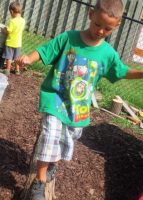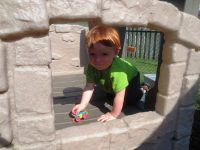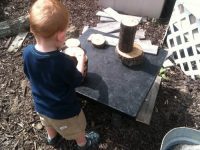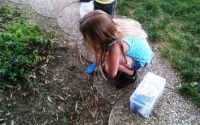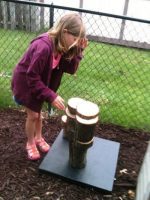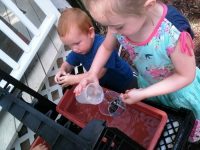The Nature Explore Classroom at
Young One’s Family Child Care
As an individual and an educator, Jennifer Young, owner of Young One’s Family Child Care, appreciates the efforts of Nature Explore and it’s partnerships to inspire children, families and educators to connect more deeply with the world around them.

While growing up, Jennifer felt she did not garner many outdoor experiences, but as an educator, she knew this was something she wanted to offer the children in her care. Jennifer states, “It can be hard when it’s not something you have learned all along or have not been formally educated in, to start the process of research and to come up with resources. When I saw the Nature Explore training offered, I jumped at the chance in the hopes that it was what I needed to springboard from. I was not disappointed.” After coming home from attending a Nature Explore Workshop, Jennifer had increased enthusiasm to offer a better outdoor classroom and now had the knowledge of the standards and principles of the Nature Explore program to succeed. With great excitement, the enrolled families and her very own family, helped her to achieve Nature Explore certification.
Initially after choosing to revitalize the outdoor classroom through the standards and principles of the Nature Explore program, a letter of explanation was sent out to all the families letting them know the plans and program needs to meet those principles. Through the next several weeks, updates were sent out via posts and photos on their public Facebook page. The posts reached upwards of 500 people, all advocating for learning through a natural environment in early childhood. Donations of time and materials also started to come in. A student’s grandfather built barn board planters using reclaimed wood from their family farm. Another family donated time in spreading mulch throughout the play garden and the front gardens. A grandmother of another child donated a bird feeder for the play garden. A father in the program introduced a variety of computer applications that children can navigate to learn about plants, animals and insect life in the outdoor classroom. The resident handy man, Jennifer’s husband, is responsible for much of the building and designing of the spaces.
The Nature Explore Classroom was designed using formal landscaping, variations in ground cover, a stepping stone path, and the natural features of the space to delineate areas from one another. The Entry Feature hosts welcoming signs of nature that change with the seasons. When embarking on the task of redesigning the outdoor space, the entire group discussed names for the areas and voted on the choices. Many areas are marked with wooden signs that one of the older children designed and made with inspiration from Nature Explore.
The Music and Movement Garden includes some permanent music features, such as a metal wind chime and other materials that can be brought out for play and taken into storage for protection from the weather. A woven basket of materials including silk scarves, bamboo ribbons, wooden and metal xylophones, wooden drums, and other instruments made from natural materials enhance this area.
The Nature Art Area developed into a space to discover with natural materials that entice sensory learning and sorting. In addition to outdoor STEM science experiments, this space acts as a secondary gathering space.
The Gathering Area is made up of a deck which houses furniture for comfort and relaxation as well as homemade barn board planters. These planters are also sources of discovery and learning for the children as they observe growth through the seasons.
The Water Area includes two water features. A homemade station allows for a variety of water discovery while a re-purposed wash tub may also be filled with water as the children need. Many additional materials are stored in this area to enhance learning. Plans are being made to add a cast iron hand. A unit of learning in this space will incorporate the fencing as a water wall with tubing, funnels, scoops, pails, and water wheels as accessories.
The Building Area includes a low table and storage to house a variety of blocks and accessories. Graduated bamboo blocks, reclaimed cedar planks of various shapes and sizes, graduated oak blocks and tree blocks all are used in this area.
The Messy Materials Area houses a low table with various sized reclaimed cedar planks, large tree cookies and pieces of a re-purposed tree donated by a community friend. Jennifer’s oldest son helped to cut these into specific sizes.
The Climbing Area includes a traditional play structure with a slide and re-purposed log as a balance beam. This log also serves as a jumping log, bridge or whatever the children imagine. Much dramatic play occurs here along with cause and effect analysis as the children experiment with items to send down the slide.
The Garden Area has native plants and features to entice sensory learning and observation for the children. In this space the children can dig in the dirt and explore what the local region has to offer. A large tree cookie path leads to a secondary water source for the outdoor classroom as well. Many times, Jennifer has observed infants showing delight while they lie under the trees in the space and experience variations in light and pattern as the breeze sways the branches overhead.
The Big Play Area is a large grassy area beyond the trees that the children know is the area they can run, kick and throw balls. Many days there are special activities set up in this area such as an obstacle course or a sprinkler, just to keep things interesting.
The Little House was gifted by a former family and is a favorite spot for the children to act out stories, and work at concepts of self through dramatic play.
The Sand Box is a table made of reclaimed cedar planks and is filled with locally harvested sand from the Mississippi River bed. This large space allows children to design, dig and build to their heart’s content either individually or in groups. It is another favorite space for dramatic play and discovery.
Jennifer would like to thank her family, all the enrolled families and the community of friends that acted in love for early education, that have helped her to reach this goal. “A big thank you goes to the Community Action of Eastern Iowa for stepping out of the box to offer this training. If not for it, I would still be floundering on how to best approach setting up a natural environment conducive to best practice learning in our outdoor classroom. We all look forward to the growth our children and program will gain from this new adventure.” With the large group effort involved in establishing a quality outdoor classroom, Jennifer feels the program will only grow better as they learn.

